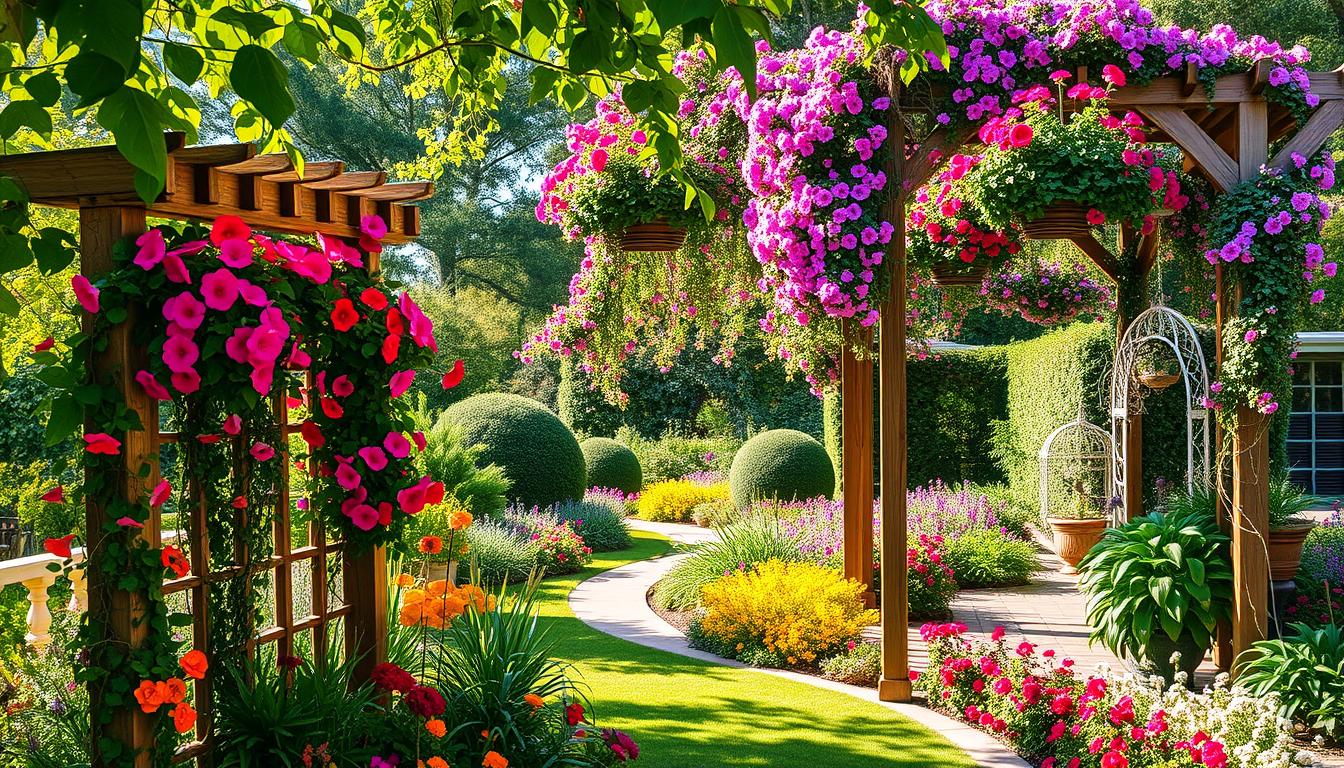Garden design and architecture are vital for creating beautiful, functional outdoor spaces. Incorporating structures like trellises and arbors can enhance both the look and use of gardens. Effective design can turn any outdoor area into a stunning retreat.
When building garden structures, consider the overall design and architecture. Choose the right materials and the perfect location. Ensure the structure complements the landscape. This way, homeowners can create a harmonious, inviting space that reflects their style.
Introduction to Garden Structures
Garden structures add visual interest and support for plants, creating defined spaces. Whether it’s a simple trellis or a complex arbor, understanding garden design and architecture is crucial. It ensures a beautiful, functional outdoor space.
Key Takeaways
- Effective garden design and architecture are essential for creating beautiful and functional outdoor spaces.
- Garden structures like trellises and arbors can enhance the aesthetic and functional value of a garden.
- Choosing the right materials and location is crucial when building garden structures.
- Garden design and architecture should complement the surrounding landscape.
- Building garden structures requires a basic understanding of garden design and architecture principles.
Understanding Garden Structures and Their Purpose
Garden structures are crucial for enhancing both the look and function of a garden. They offer garden support and plant support, vital for plant health and growth. A well-chosen structure can beautify the garden, add depth, and divide it into sections.
Key benefits of garden structures include:
- Improving outdoor looks by adding texture, color, and interest
- Supporting plant growth by giving plants a framework to climb or spread
- Creating clear garden areas, like seating spots or paths
Enhancing Outdoor Aesthetics
Garden structures can boost a garden’s outdoor beauty by introducing decorative elements. Trellises, arbors, or pergolas are examples. These can be crafted from wood, metal, or stone, matching the garden’s style.
Supporting Plant Growth
Offering plant support is key for plant health and growth. Structures like trellises or stakes help plants that climb or spread. They keep plants upright, aiding in healthy development.
Creating Defined Garden Spaces
Garden structures help define spaces within the garden, like seating areas or paths. This creates depth and visual appeal, making the garden more interesting. It also offers a practical space for outdoor activities.
| Garden Structure | Purpose | Benefits |
|---|---|---|
| Trellis | Supporting plant growth | Provides a framework for plants to climb, adds visual interest |
| Arbor | Creating a defined garden space | Provides shade, creates a sense of depth and visual interest |
| Pergola | Enhancing outdoor aesthetics | Adds texture and interest to the garden, provides a sense of depth |
Essential Tools and Materials for Construction
Building garden structures requires the right tools and materials. The selection of structural elements is critical for durability and stability. A comprehensive toolkit, from hammers and saws to drills and sanders, is vital for any project.
Materials like wood, metal, and PVC offer various benefits. The choice depends on the project’s specific needs. Wood, for instance, is favored for its aesthetic appeal and versatility in design.
- Posts and beams
- Roofing materials
- Wall panels
- Doors and windows
These components form the structure’s framework and support, ensuring safety and security.
By selecting the appropriate tools and materials, and focusing on structural elements, gardeners can craft structures that are both beautiful and functional. These structures will bring joy and satisfaction for years to come.
| Material | Benefits | Drawbacks |
|---|---|---|
| Wood | Aesthetically pleasing, easy to shape and mold | Can be prone to rot and insect damage |
| Metal | Durable and long-lasting, can be recycled | Can be expensive, may require special tools and equipment |
| PVC | Low maintenance, resistant to rot and insect damage | May not be as aesthetically pleasing as other materials |
Planning Your Garden Structure Project
Creating a stunning and practical garden starts with a solid plan. This is crucial when adding vertical gardening features. They not only save space but also enhance your garden’s look.
Selecting the Perfect Location
Begin by choosing the right spot for your garden. Consider the sunlight, shade, wind, and weather it will face. It should also be close to your home or patio for easy access and visibility.
Determining Size and Scale
After picking a location, think about your garden’s size and scale. Consider the plants you want to grow and any decorative items. A well-designed vertical gardening system maximizes space and adds beauty to your garden.
Creating Construction Drawings
Now, create detailed drawings for your garden structure. This step helps you see your design and ensures everything fits well together. Include vertical gardening elements like trellises or wall-mounted planters in your plans.
| Garden Structure Element | Purpose | Considerations |
|---|---|---|
| Trellis | Support for climbing plants | Material, size, and placement |
| Arbor | Shade and decorative element | Size, material, and style |
| Wall-mounted planter | Space-saving planting option | Size, material, and drainage |
Building a Classic Garden Trellis
A classic garden trellis is a beautiful and functional addition to any garden. It provides support for climbing plants to grow and thrive. When building a trellis, it’s essential to consider the type of plants that will be using it. Also, the overall aesthetic of the garden is important.
To start, gather the necessary materials, including wooden posts, wire mesh, and a hammer. Then, follow these steps:
- Dig holes for the posts and set them in place, making sure they are level and secure.
- Attach the wire mesh to the posts, weaving it in and out of the wooden slats to create a sturdy structure.
- Train the climbing plants to grow up the trellis, using twine or clips to gently guide them.
As the plants grow, they will begin to cover the trellis, creating a beautiful and lush display. To add a finishing touch, consider adding a decorative top or a coat of paint. This will protect the wood and enhance the overall appearance.
With a little creativity and some basic building skills, you can create a stunning garden trellis. It will provide years of enjoyment and support for your favorite climbing plants.
| Trellis Type | Materials Needed | Difficulty Level |
|---|---|---|
| Wooden Trellis | Wooden posts, wire mesh, hammer | Easy |
| Metal Trellis | Metal posts, wire mesh, screwdriver | Medium |
| Bamboo Trellis | Bamboo posts, twine, scissors | Hard |
Crafting an Elegant Garden Arbor
Garden arbors add elegance and sophistication to any garden. They serve as a stunning focal point, drawing the eye and sparking wonder. To create an elegant garden arbor, focus on the structural elements that support it and enhance the garden’s beauty.
Key considerations for building an arbor include:
- Choosing the right materials, such as wood or metal, to create a sturdy and durable structure
- Designing the arbor to complement the existing garden design, taking into account the style and architecture of the surrounding landscape
- Selecting plants that will thrive in the arbor’s environment, such as climbing vines or flowering shrubs
An elegant garden arbor can transform any garden into a tranquil oasis. By carefully selecting structural elements and garden design, you can craft a stunning arbor. It will undoubtedly enhance the beauty of your outdoor space.
Designing Functional Plant Support Systems
In the realm of gardening, plant support is vital for plant health and longevity. A well-crafted garden support system significantly enhances both the look and productivity of your outdoor area. To create an effective plant support system, understanding your plants’ specific needs is key. This includes their growth patterns and how much weight they can bear.
A suitable plant support system must offer the necessary framework for climbing plants to flourish. Options range from trellises to arbors, all falling under garden support categories. When picking a support system, consider the types of plants you aim to cultivate and their unique demands. Some plants necessitate more support due to their size or weight.
Climbing Plant Requirements
- Opt for a plant support system that’s sturdy enough to hold the plants’ weight
- Choose a system that accommodates the plants’ growth patterns and is easy to maintain
- Reflect on the support system’s aesthetic value and how it will complement your garden’s design
Weight-Bearing Considerations
Weight-bearing capacity is another critical factor in selecting a plant support system. This ensures the system can handle the plants’ weight, as well as any additional loads from wind or snow. By investing time in designing a functional plant support system, you can cultivate a stunning and productive garden. This garden will offer years of pleasure and enjoyment.
Incorporating Vertical Gardening Elements
Vertical gardening brings a new dimension to any garden, enhancing both its look and space efficiency. It allows gardeners to boost their garden architecture and offer more room for plants to grow.
Vertical gardening offers several advantages, such as higher yields, better air quality, and less soil erosion. To begin, consider the following steps:
- Choose a location with plenty of sunlight
- Select a variety of plants that thrive in vertical conditions
- Use a trellis or other support system to train plants to grow upwards
By adding vertical gardening elements to your garden design, you can craft a unique and flourishing outdoor area. It highlights your garden architecture prowess. Whether your space is small or expansive, vertical gardening maximizes your area and brings gardening’s many benefits to life.
Vertical gardening is not just about growing plants, it’s about creating a work of art that showcases your personality and style.
Weatherproofing and Protecting Your Garden Structures
To ensure your garden structures last, weatherproofing and protection are key. You need to pick the right structural elements and use proper garden support. This helps them stand up to different weather conditions.
Weatherproofing involves several important factors. These include:
- Selecting weather-resistant materials for your garden structures
- Applying protective treatments to prevent damage from the elements
- Performing regular seasonal maintenance to ensure the longevity of your garden structures
By following these steps, you can safeguard your garden structures. This ensures they remain a stunning and functional part of your outdoor area.
Popular weather-resistant materials include cedar, teak, and recycled plastic. These are tough and can handle the elements well. Using a sealant or stain can also help your structures last longer.
| Material | Benefits |
|---|---|
| Cedar | Naturally resistant to rot and insect damage |
| Teak | Highly durable and resistant to warping |
| Recycled Plastic | Low maintenance and resistant to fading |
Choosing the right materials and weatherproofing your garden structures ensures they last. This way, you can enjoy your outdoor space for many years.
Creative Design Ideas for Modern Gardens
The realm of garden design is vast and exciting. A garden can serve as a peaceful retreat, a lively spot for gatherings, or a thriving habitat. Modern gardens often feature sustainable materials and advanced technology. These elements help create unique, functional outdoor areas.
Integrating garden architecture into your design can elevate its appeal and interest. Consider adding pergolas, water features, and outdoor kitchens. With thoughtful planning and meticulous detail, you can craft an outdoor space that showcases your style and fulfills your needs.
Some current trends in garden design include:
- Utilizing native plants and materials to enhance the garden’s sense of place and reduce environmental impact
- Employing vertical elements, like living walls and trellises, to boost visual appeal and space efficiency
- Designing outdoor rooms and zones, such as seating and dining areas, to segment the garden
By embracing these trends and adding your personal flair, you can design a modern garden that’s both stunning and practical. Whether you aim to host, unwind, or simply enjoy nature, a well-planned garden offers a sanctuary. With dedication and attention to detail, you can realize your vision and create a remarkable outdoor space that mirrors your unique taste and fulfills your desires.
| Design Element | Description |
|---|---|
| Water Feature | A fountain, pond, or other water feature can add visual interest and create a soothing atmosphere |
| Outdoor Kitchen | A fully equipped outdoor kitchen can be a great space for entertaining and outdoor dining |
| Living Wall | A living wall or trellis can add a touch of greenery and help to purify the air |
Integrating Lighting and Decorative Elements
To enhance the ambiance and functionality of garden structures, integrating lighting and decorative elements is crucial. Solar lighting options offer a sustainable light source, enhancing vertical gardening features. Strategically placed solar lights highlight garden beauty, providing plant support by illuminating plants and creating a warm ambiance.
Some popular solar lighting options include:
- String lights: perfect for wrapping around trellises or arbors
- Pathway lights: great for illuminating walkways and highlighting garden features
- Spotlights: ideal for accentuating specific plants or garden structures
Ornamental additions like sculptures, bird baths, or benches also boost garden aesthetics. These elements can be scattered throughout the garden, creating visual interest and harmony. By adding these features, you create a beautiful, functional outdoor space that showcases your vertical gardening prowess and provides ample plant support.
Seasonal decorating is key to maintaining a dynamic, inviting outdoor space. For instance, add pumpkins and fall leaves in autumn or flowers and greenery in spring. This approach ensures your garden structures and vertical gardening features are always complemented.
| Season | Decorating Ideas |
|---|---|
| Spring | Flowers, greenery, pastel colors |
| Summer | Bright colors, outdoor furniture, string lights |
| Autumn | Pumpkins, fall leaves, warm colors |
| Winter | Evergreen branches, snowflakes, warm lighting |
Common Construction Mistakes to Avoid
When building garden structures, it’s crucial to select the right structural elements for stability and durability. A frequent error is neglecting the importance of proper garden support. This oversight can result in structural failures and pose safety risks.
To sidestep these pitfalls, consider the following:
- Opt for high-quality materials that can endure various weather conditions
- Design the structure with proper weight distribution and balance in mind
- Implement a robust garden support system to prevent collapse or damage
By recognizing these common construction errors, you can craft a beautiful and functional garden structure that will endure for years. Always prioritize structural elements and garden support to guarantee a safe and enjoyable outdoor area.
Conclusion: Transforming Your Outdoor Space with Beautiful Garden Structures
Garden structures, such as trellises and arbors, can dramatically change your outdoor area. They not only beautify your garden but also aid in plant growth and create distinct zones.
By adding well-designed garden structures, you can boost your yard’s look. You’ll also get the perks of better plant support, more privacy, and a more organized layout. Whether you choose a traditional trellis or a sophisticated arbor, the options are vast for making your outdoor space unique.
This detailed guide should have motivated you to dive into the realm of garden structures. With the right tools, materials, and creativity, you can craft a beautiful and practical garden. It will surely impress your neighbors. Enjoy the process of building!


